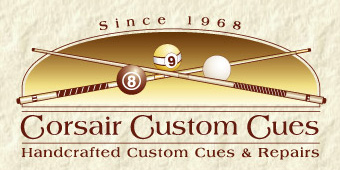
How to Identify a Corsair Cue
|
The first era of cues ever made are denoted by the use of a brass pin in the shaft. Shortly thereafter the brass pin was switched to the handle. In 1972 that pin was permanently replaced by stainless steel. From the inception a thin set wide base shallow bumper was used. Around 1980 a deeper set narrower based thick bumper replaced it. In 1985, the use of manufactured brass inserts in shafts started to appear. The early Black Beauty cues have the appearance of a black piece of wood. The wood grain was very prominent prior to 1984 when a change in the industry diminished the prominence of the grain. Throughout the decades, Corsair cues have always used quality materials and brand names synonymous with fine cues while adapting with the changes available to the billiard industry. These changes are very subtle but worth noting when identifying a cue.
Corsair cues do not use model numbers for identification. Instead, only unique series and one of a kind cues were named based on the design. For the purpose of the For Sale web page and the Blue Book of Pool, reference codes are present. The cues made in the 60's, 70's, & early 80's were styled with thick, large and bold designs. The designs consisted of geometric shapes such as circles, squares, rings and rectangles. The cues with the "Rose Blossom" design feature a large dot encircled by by smaller dots. These are among the most rare and valued cues. Towards the late 80's, cue designs shifted to thin and subtle geometric designs.
Finishes
Corsair Cues are never stained. Only through the use of exotic woods are colors obtained. Early models had a "French Polish" finish. The late 80's marked the beginning of lacquer and acrylic coated cues. It wasn't until a few years after that the use and refinement of urethane coatings took over.
There is a time period from 1976 through 1992 that Hank's three sons started making cues. Each son started at different times in that era however 90% of all cues were still made by Hank. For years Corsair Cues did not have a logo or name on the cue until approximately 1981, when the name and a dash before and after was engraved in the butt plate. From around 1989 through 1992 the individual maker marked each cue. Only Corsair Custom Cues can verify the authenticity and the maker of our cues. After Hank passed on, all Corsair Custom Cues produced are engraved with a dot before and after the name in the butt plate. |